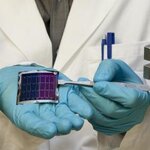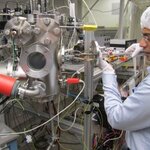Energy

Loofahs, those exfoliating things for skin that men pretend they don't use in the shower, may be a new potential tool to advance sustainability efforts of both energy and waste, according to a paper in the journal Environmental Science&Technology.
The study describes the pairing of loofahs with bacteria to create a power-generating microbial fuel cell (MFC). Shungui Zhou and colleagues note that MFCs, which harness the ability of some bacteria to convert waste into electric power, could help address both the world's growing waste problem and its need for clean power. Current MFC devices…

Thermionic conversion to heat energy, such as light from the sun or heat from burned fossil fuels, can mean very high efficiency, and because of its promise has been researched for over 50 years with little success.
That may soon change, thanks to a new design, dubbed a thermoelectronic generator, described in the Journal of Renewable and Sustainable Energy.
Thermionic generators use the temperature difference between a hot and a cold metallic plate to create electricity.
"Electrons are evaporated or kicked out by light from the hot plate, then driven to the cold plate, where they condense…

For many years scientists and engineers have been trying to provide low-cost solar energy by developing a cheap solar cell that is both highly efficient and at the same time simple to build, enabling it to be mass produced. Now, the team led by Empa researcher Ayodhya N. Tiwari has made a major leap forward: the researchers are presenting a new manufacturing technique for CIGS solar cells, in which tiny quantities of sodium and potassium are incorporated into the CIGS layer.
The special treatment alters the chemical composition of the complex sandwich structure – thereby altering its…

Maybe you like to eat carp. Invasive Asian carp have been successfully harvested and served on a dinner plate but the idea of similarly harvesting invasive plants and converting them into ethanol isn't realistic yet - even less realistic than currently mandated and subsidized ethanol.
Obviously, harvesting invasive plants for use as biofuels is a great idea and merits basic research but from a policy point of view, let's hope the government does not start throwing money at companies. For now, it faces poses numerous obstacles and is too expensive to consider, at least with the current…

As portable electronic devices such as laptops and smartphones get more robust, consumers would like for batteries to keep pace. But rechargeable batteries -- Lithium-ion (Li-ion) being among the most popular - haven't done that. They are 25 year old technology powering things produced this year.
Japanese researchers from a prive sector-government team report an advance in Li-ion battery technology that they describe as a major breakthrough. They fabricated a cathode (positive electrode) of lithium cobalt oxide (LiCoO2) in which the compound's individual grains are aligned in a specific…

The sun uses fusion energy and everyone likes the idea of solar power but it requires a lot of infrastructure to translate that fusion energy to our usable kind. Fusion energy on Earth has been studied for decades, and it really isn't close, but if it takes another 50 years, it will be worth it. For that to happen, some known obstacles have to be overcome.
Currently, researchers use magnetic fields to insulate hot plasma from the walls of the chamber and maintain the reaction and prevent damage to interior surfaces. In the tokamak, one of the contenders to achieve a sustained fusion…

Outside the companies getting subsidy money from the government, not many people like wind turbines.
It wasn't efficient in the 1300s and is not very good now, so energy scientists think it is a waste. There have been constant complaints about noise and health effects and putting them in remote places, like off the coast, has been a non-starter because rich political donors in the northeast don't want their yachting spoiled. Some environmental groups have bucked their fellows and noted that if a regular citizen killed endangered birds, they would be in federal prison, but the administration…

If you have traveled, you know that in some other countries the voltage used in homes and businesses are different than where you live. But not the type of electricity; all countries use alternating current. Yet a lot of appliances and devices then convert it to DC.
In the early days of electricity, the war was on between alternating current and direct, with Westinghouse (and Tesla) advocating the former and Thomas Edison standardizing on the latter. The reason alternating current won is because people didn't want power plants in their neighborhoods and banks of batteries in their homes. And…

A new study correlates a series of small earthquakes near Snyder, Texas between 2006 and 2011 with the underground injection of large volumes of carbon dioxide (CO2), long before the adoption of current hydraulic fracking and a finding that is relevant to the process of capturing and storing CO2 underground.
Fracking has gotten a bad rap, including being blamed for things it couldn't possibly have caused. In 2012, a US District Court had to order the EPA to stop blaming fracking and penalizing companies involved in energy extraction without conducting an investigation first.
The new…

Wind farms can be part of our future energy mix assuming the cost of offshore turbine energy versus their efficiency can be made manageable. A new computer projection found a better way to arrange the turbines is a step in the right direction. A team from the University of Delaware found that staggering and spacing out turbines in an offshore wind farm can improve performance by as much as 33 percent.
The researchers used an existing offshore wind farm near Sweden as the basis for their study, comparing the existing tightly packed, grid-like layout to six alternative configurations. In…